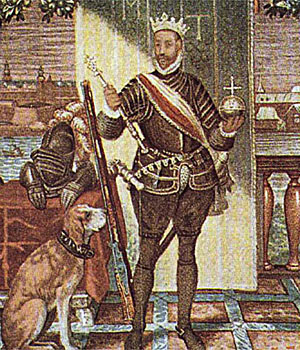| Opførelsen af Kronborg

| | Efter reformationen i 1536 overtager kongemagten kirkens vidtstrakte jordegods i Nordsjælland.
Ved at bytte ejendomme med adelen samles store dele af kongemagtens jordejendom i Nordsjælland og under Frederik 2.(1559-1588) begynder opførelsen af fyrsteboliger i renæssancestil. |
Skåne bliver i løbet af 1500-tallet overvejende adelens domæne, mens kongemagten samler store dele af sine besiddelser i Nordsjælland. Kongen bytter jord med en række adelsfamilier og i Frederik 2.s regeringstid(1559-88) påbegyndes et storstilet nybyggeri med Frederiksborg og Kronborg Slot.
Øresundstolden omlægges
Ved Helsingør lå endnu ved midten af 1500-tallet kongens middelalderborg Krogen og gennem indtægterne fra Øresundstolden havde kongemagten også tæt tilknytning til byen. I 1567 beslutter Frederik 2., på foranledning af lensmanden Peder Oxe, at omlægge Øresundstolden således at der fremover ikke betales pr. skib, men efter ladningens værdi. Det medfører en betydelig forøgelse af indtægterne fra 45.000 daler i 1566 til 132.500 daler i det efterfølgende år og stigende til omkring 200.000 daler årligt i 1620´erne.

Krogen 1420 |
Det nye Slot
I begyndelsen af 1570erne opstår så tanken om at opføre er mere tidssvarende anlæg på dette strategisk vigtige sted. Projektet påbegyndes i 1574 i en første fase frem til 1577. Dette år foretages en revision af byens privilegier, der tilsiger frihed fra skat "og anden besværing" i 20 år.
Kongen understreger i privilegiebrevet at tilflytterne skal nyde de samme friheder og privilegier som de fastboende, men også undergive sig borgmester, rådmænd og stadsretten. Formodentlig har kongen brug for at skabe bedre vilkår for de mange tilrejsende håndværkere og tillige vinde borgernes velvillighed omkring det store projekt ved Kronborg. Endnu et vidnesbyrd om kongens imødekommenhed overfor byen kommer måneden efter:
"...Eftersom borgermestre og råd i Helsingør haver givet tilkende, at det marked, der holder der ved Sct. Mikkels dag, er byen mere til skade og besværing end gavn, nytte og forfremmelse, så skal dette marked aldeles aflægges, på det at borgerne i Helsingør ikke skal have hinder og skade deraf på deres handel, næring og bjergning..."
Bygherren Frederik II
Opførelsen af Kronborg og det liv der udfoldede sig her omkring viser Frederik 2. som den virkelystne og alsidigt interesserede renæssancefyrste. Kongen følger med nidkær interesse byggeriets udvikling, blander sig ned til mindste detalje, og har afgørende indflydelse på byggeriets endelige udformning.
Der eksisterer bl.a. i Øresundtoldens regnskaber et righoldigt materiale til at belyse forskellige faser og enkeltheder i forbindelse med slottets opførelse og påfølgende ombygninger og indretning. Ud fra regnskaberne kan den samlede pris for byggeriet anslås til 430.000 daler.
To byggefaser
Kronborg blev ikke bygget efter en på forhånd fastlagt plan, men udviklede sig over Krogens grundplan. Erik af Pommerns Krogen var en middelalderfæstning, kvadratisk i sin grundform, 80 meter på alle leder og med et hus i hvert hjørne, bygget ind i ringmuren og med udgang mod nord. Det er over denne grundplan at Frederik 2.lader opføre sit Kronborg i 2 faser.
Kongen ansætter bygmestre (arkitekter) fra Flandern til at forestå arbejdet, i første omgang fra 1574-77 Hans van Paeschen (Hans Påske) og dernæst fra 1578 Antonius van Opbergen fra Mecheln. Flamske stenhuggere tog sig af stenhuggerarbejdet, mens træarbejdet udførtes af danske håndværkere.
Den fyrstelige udsmykning
Bygningen fremstår oprindelig i røde teglsten med vinduesindfatninger og ornamenter udført i sandsten, men beklædes under Antonius van Opbergens ombygning med sandstenskvadre og kobbertag. Måske har man ment, at byggeriet hermed fik et fyrsteligt særpræg, der adskilte det fra adelens mange samtidige herregårdsbyggerier i rødsten.
Hans Knieper fra Antwerpen, der forestod den indre udsmykning med vævede gobeliner, udførte omkring år 1582 en tegning der viser slottet. Østfløjen er dog på dette tidspunkt endnu ikke opført i fuld højde og det store sydtårn mangler endnu den kuppel der prydede det fuldførte slot.

Kronborg 1582 |
Indvielsen af Kronborg
I et åbent brev fra januar 1577 bestemmer Frederik den 2. at navnet på den nye fæstning ved Helsingør skal være Kronborg. Omkring 1582 har kong Frederik åbenbart ment, at værket var såpas fuldendt, at det kunne indvies, hvilket sker d.15. april med klokkeringning, afskydning af kanoner og uddeling af penge til de fattige.
Sommeren 1582 tages slottet i brug til repræsentative formål i forbindelse med at kongen skal modtage hosebåndsordenen af engelske gesandter.
Begivenheden finder sted d.13.august 1582, og den engelske gesandt, Lord Willoughby, skriver noget lakonisk i sin indberetning til dronning Elisabeth, at "...alt det grove skyts blev affyret, og der blev givet et kongeligt gilde og et meget kunstigt og vel indrettet fyrværkeri"
Færdiggørelsen
Endnu har den store riddersal, der regnes for Nordeuropas største, ikke været klar til ibrugtagning, men det har været omgivelser der har været værdige for en renæssancefyrste. Der arbejdes således videre med byggeriet efter 1582, bl.a. tilføjes kuplen på det store tårn i 1583, og først omkring 1585 står slottet i den endelige skikkelse, som Frederik 2.ønskede.
Et prospekt af hollænderen Abraham Booth viser det fuldførte slot med Sundet og Helsingborg og Kärnan i baggrunden.

Kronborg ca.1590 | 
Kronborg før branden i 1629 |
|